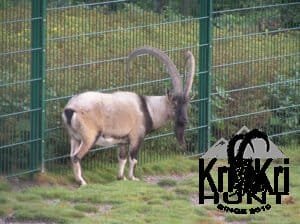
What is NOT the Kri-Kri Ibex?
The Kri-kri ibex is NOT the subspecies of bezoar ibex.
Recent scientific genetic studies have disproved that the Kri Kri is related to the bezoar ibex. On the other hand, some outfitters in Turkey are still trying to push this concept.
https://auction.safariclub.org/10-day-Turkey-Taurus-Bezoar-Ibex-and-Coastal-Ibex-Hunt-for-One-Hunter_i43880208
The agrimi goat Capra aegagrus cretica is unique to Crete and its offshore islands. It has been identified as a sub-species of the wild bezoar goat Capra aegagrus aegagrus Erxleben, 1777, which it closely resembles in horn shape, body form, and coloration. This classification has been disputed by some researchers who claim that the agrimi is feral goats derived from early domestic stock brought to the island by the first Neolithic settlers. To clarify this issue DNA analyses (cytochrome b and D loop sequences) were carried out on tissue of live and skeletonized agrimi and compared to sequences of wild and domestic caprines. Results conclusively show the agrimi as a feral animal that clades with domestic goats (Capra hircus) rather than wild Asiatic bezoar. This study demonstrates that morphometric criteria do not necessarily reflect genetic affinities and that the taxonomic classification of agrimi should be revised.
https://zslpublications.onlinelibrary.wiley.com/doi/abs/10.1017/S0952836902000407

What is the Kri-Kri Ibex?
The Kri-kri ibex is one of the European protected species. Kri Kri ibex or the agrimi goat Capra aegagrus cretica is unique to Crete and its offshore islands. However, it is not found in any other country, so there are specific rules for hunting it in Greece. The ibex is a wild animal mainly living in mountainous areas on the islands Sapientza, Atalanty, and Crete and its offshore islands. Still, it is illegal to hunt it on Crete. It is also a species that is easy to domesticate. Therefore, it can be kept in captivity. The Kri-kri ibex is brown grey in color with a dark cross on the back and dark chess. The male ibex has large, curved horns. You can easily recognize a Kri-kri ibex by its curved horns and black cross. The horns curve towards the back of the head. The female ibex has smaller and straighter horns than the male.
What is hybrid Kri-Kri Ibex?
The Hybrid Kri-Kri Ibex crosses the “Kri-Kri Ibex” and a “Feral Goat”. According to current research, the kri-kri is not considered indigenous to Crete; it is thought to have been imported to the island during the Minoan period. The kri-kri is currently preserved in two wild sub-populations on Sapientza island and Atalanty island. By 1960, the kri-kri was under threat on Crete, with a population below 200. It had been the only meat available to mountain guerillas during the German occupation in World War II. Its status was one reason the Samaria Gorge became a national park in 1962. There are still only about 2,000 animals on the island, and they are considered vulnerable: poachers still seek them for their tender meat. Hybridization is also a threat, as the population has interbred with ordinary goats. It is unknown to most people that goats can swim and even move from island to island in search of food. Every year on Crete and the three small islands just offshore (Dia, Thodorou, and Agii Pantes), the government catches and removes part of the overpopulation of mixed Hybridized goats. Most probably, they are relocated to two places: a zoo area in northern Greece and a breeding island.
Relocated animals are hybridized goats, but some still have morphometric criteria of the Kri kri ibex, especially the black cross on their back. It is a public secret that part of that relocated animals, despite the EU law and restrictions for trade with that animal, are sold as hybrid goats and exported to North Macedonia and Croatia. In those countries, the hybrids could be hunted as “kri kri ibex”. A small number of these specimens are sold each year to private hunting area on the “Main Land” in Northern Greece and could be hunted in a high-fenced area for dog training.
The goats that have been moved are crossbred hybrids, but some of them still possess the morphological characteristics of the Kri Kri ibex. Despite EU legislation prohibiting the sale of these animals, some of them are still sold as “Kri Kri ibex” and imported to North Macedonia and Croatia. These “feral goats” or hybrids can be hunted as Kri kri ibex in these countries. A small number of the “feral goats” are sold annually to private hunting area in Northern Greece and hunted in enclosed areas for dog training. All of the hybrids outside of Greece originate from a zoo.
More stories for Kri Kri ibex


Stand for Ethical Hunting – Petition

Hunting Kri-Kri Ibex: A One-of-a-Kind Experience

How Trophy Hunting Saved the Kri Kri Ibex From Extinction: A Historical Analysis

What is illegal Hunting for Kri-Kri Ibex?

What is the Kri-Kri Ibex?

Greece needs assistance to reinstate bow hunting

What? You never heard this before? Goats can swim.

Sapientza island Kri Kri ibex- treasure hunt

Kri Kri ibex bow hunt

Top 3 at SCI – Kri Kri ibex

Happy New Year 2022 Kri Kri hunt

Wild Wild West & Kri Kri hunting

What a story! What a Kri Kri hunt!

One-shot, one Kri Kri ibex is enough. Congratulations Rodrigo !

Ancient Olympic Games winners

Sapientza mouflon – challenge for all OVIS hunters

Shooting with shotgun a Kri Kri ibex is not easy

Bullseye on 150 meters with shotgun on a Kri Kri ibex
